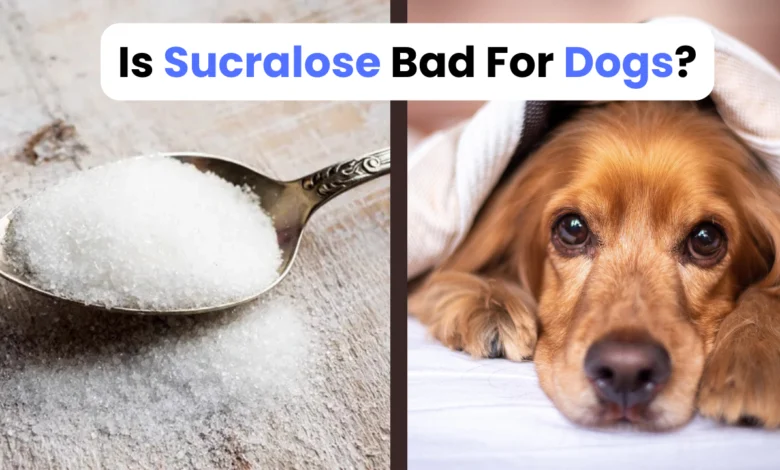Is Sucralose Bad For Dogs?

You’re enjoying a sweet treat, and those puppy-dog eyes beg for a bite. It’s tempting to share, but what if that snack contains ingredients that could harm your furry friend? Many pet owners don’t realize that everyday foods—even sugar-free ones—might hide risks for their dogs.
Artificial sweeteners, like sucralose, are common in human snacks but aren’t always safe for pets. While research on this specific ingredient is ongoing, veterinarians warn that some sugar substitutes can cause digestive upset or worse. Puppies, with their smaller bodies and curious appetites, are especially at risk.
This article explores what every responsible pet owner should know. We’ll break down how certain sweeteners affect dogs, share signs of trouble to watch for, and explain steps to take in an emergency. You’ll also learn how pet insurance can help cover unexpected vet costs.
Overview of Artificial Sweeteners and Their Use in Foods
Supermarket shelves are filled with products boasting “sugar-free” labels, thanks to artificial sweeteners. These additives let food makers cut calories while keeping flavors sweet. But not all sweeteners are created equal—some hide risks for pets.
Introducing Common Sweeteners in the Market
Four major sugar substitutes dominate store products:
- Stevia: Plant-based, often in drinks and snacks
- Aspartame: Found in diet sodas and sugar-free gum
- Saccharin: Used in baked goods and tabletop sweeteners
- Xylitol: Common in peanut butter and toothpaste
How Sweeteners Are Incorporated into Everyday Products
Manufacturers blend these ingredients into items you might not expect. Check labels carefully—even “natural” products can contain synthetic additives. Here’s where they often appear:
| Sweetener | Common Products | Pet Risk Level |
|---|---|---|
| Xylitol | Gum, mints, baked goods | High toxicity |
| Aspartame | Diet sodas, yogurt | Low risk |
| Stevia | Protein bars, teas | Generally safe |
| Saccharin | Canned fruits, jams | Mild concerns |
While many sweeteners pose minimal threats to humans, xylitol stands out as extremely dangerous for dogs. Even small amounts in sugar-free gum can trigger emergencies. Always store these products securely and read ingredient lists before sharing snacks.
Sucralose Bad For Dogs: What the Research Tells You
Hidden in everyday snacks, certain sugar substitutes could unsettle your pet’s stomach. While some sweeteners get more attention for their dangers, others fly under the radar despite potential risks. Let’s examine what studies say about one widely used ingredient.
Chemical Profile and Food Applications
This calorie-free additive is made by modifying sugar molecules with chlorine atoms. It’s 600 times sweeter than regular sugar, making it popular in diet drinks, baked goods, and sugar-free syrups. Unlike xylitol—a known danger—it doesn’t trigger insulin spikes in most cases.
Gut Health and Metabolic Concerns
Veterinary reports suggest high doses might lead to loose stools or vomiting. A 2022 study in the Journal of Veterinary Pharmacology found:
“Dogs consuming over 100mg per kg body weight showed mild diarrhea, but no liver enzyme changes were observed.”
Here’s how different sweeteners stack up in canine safety:
| Additive | Safe Limit | Primary Risk |
|---|---|---|
| Xylitol | 0.1g/kg | Liver failure |
| Stevia | Not established | Upset stomach |
| Aspartame | 40mg/kg | Headaches |
| Sucralose | 100mg/kg | Diarrhea |
While serious issues are rare, watch for these signs after accidental ingestion:
- Excessive thirst
- Lethargy lasting over 12 hours
- Unusual bowel movements
Always consult your vet if symptoms persist—timely treatment prevents complications. The next sections explore how other additives compare in toxicity levels.
Key Differences Between Sucralose and Other Sweeteners

When scanning ingredient lists for your pup’s safety, not all sweeteners pose equal risks. Natural options like stevia and monk fruit extract come from plants, while artificial versions are lab-created. This distinction often impacts how dogs process these substances.
Plant-Based vs. Synthetic Additives
Stevia, derived from leaves, rarely causes issues beyond mild stomach upset in large doses. Monk fruit—another natural option—hasn’t shown toxicity in animal studies. Synthetic sweeteners like aspartame and saccharin, however, may trigger headaches or digestive discomfort in sensitive pets.
Risk Levels Across Common Options
Consider this comparison when choosing treats or checking labels:
| Sweetener | Source | Canine Risk |
|---|---|---|
| Xylitol | Birch wood | Emergency-level |
| Aspartame | Lab-made | Low |
| Stevia | Plant leaves | Minimal |
| Saccharin | Coal tar | Moderate |
Watch for xylitol in sugar-free gum or baked foods—it’s 100x more toxic than other options. A 10-pound dog can suffer liver failure from just one piece of gum. Always verify labels on peanut butter, toothpaste, and diet snacks before sharing.
Dr. Ellen Parker, a veterinary nutritionist, notes: “Natural doesn’t always mean safe, but plant-based sweeteners generally have fewer red flags than synthetic ones.” Stick to unsweetened products when possible to avoid guessing games.
Recognizing Signs of Sweetener Toxicity in Pets
Your dog just snagged a sugar-free cookie—what happens next? Early detection of harmful reactions can save your pet’s life. Watch closely for sudden changes in behavior or physical condition after accidental ingestion.
Common Symptoms from Ingesting Harmful Sweeteners
Xylitol triggers rapid blood sugar drops in dogs. Within 30 minutes, you might see:
- Stumbling or inability to stand
- Pale gums and excessive panting
- Seizures or sudden collapse
Severe cases involving high xylitol levels often lead to liver injury within 12-24 hours. Check this symptom progression table:
| Symptom Stage | Timeframe | Action Required |
|---|---|---|
| Vomiting/Diarrhea | 0-2 hours | Call vet immediately |
| Weakness/Confusion | 2-6 hours | Emergency visit |
| Jaundice/Black Stool | 12+ hours | Hospitalization likely |
Identifying Early Warning Signs of Toxicity
Subtle clues often appear before major illness develops. Notice if your pet:
- Drinks water obsessively
- Refuses favorite treats
- Shows unusual aggression
“Blood work irregularities—even minor ones—can signal developing liver issues. Don’t wait for visible symptoms.”
Dr. Lisa Carter, Veterinary Emergency Specialist
Track these key indicators if exposure occurs:
| Risk Level | Blood Sugar Reading | Liver Enzyme Status |
|---|---|---|
| Mild | 60-80 mg/dL | Normal |
| Critical | Below 40 mg/dL | Elevated ALT/AST |
Emergency Response: What to Do If Your Dog Consumes a Harmful Sweetener
When your dog ingests a toxic sweetener, acting fast can make the difference between life and death. Immediate intervention often prevents severe complications. Follow these steps to protect your pet’s health during critical moments.
Critical First Steps
1. Remove remaining treats: Clear your pet’s mouth of any leftover substances. Use gloves to avoid accidental exposure.
2. Note the time: Track when ingestion occurred. Treatment effectiveness depends on swift action within the first 30 minutes.
3. Contact your vet or animal poison control: Call the ASPCA Animal Poison Control Center (888-426-4435) while heading to the clinic.
| Time Since Ingestion | Recommended Action | Veterinary Procedures |
|---|---|---|
| 0-30 minutes | Induce vomiting if advised | Activated charcoal administration |
| 30-60 minutes | Transport to clinic immediately | Blood sugar monitoring |
| 1+ hours | Monitor for symptoms | Liver function tests |
Veterinarians typically perform two key assessments: blood tests to check glucose levels and liver enzymes. Dr. Rachel Kim, an emergency vet, states:
“We prioritize stabilizing blood sugar before addressing potential organ damage. Delays beyond two hours dramatically reduce survival rates.”
Keep your pet calm during transport. Avoid home remedies like milk or hydrogen peroxide unless directed by a professional. Most insurance plans cover these emergencies—confirm coverage details en route.
Managing Costs and Understanding Pet Insurance Coverage

Emergency vet visits can strain your budget, but the right insurance plan eases the burden. Treatment for sweetener toxicity often requires urgent care, bloodwork, and overnight monitoring. Knowing what to expect financially helps you act decisively during crises.
Typical Veterinary Treatment Expenses
PetSure’s 2021 data shows the average cost for toxin-related emergencies ranges from $800 to $2,500. Severity determines final bills:
| Treatment Type | Average Cost | Insurance Coverage |
|---|---|---|
| Blood glucose stabilization | $300-$600 | 80-90% reimbursed |
| Liver function monitoring | $500-$1,200 | Subject to deductible |
| Hospitalization (24hr) | $1,000-$2,000 | Varies by policy |
Plans often exclude pre-existing conditions, so enroll your pet early. Waiting periods of 14-30 days usually apply before coverage begins.
How Your Pet Insurance Policy Can Assist in Emergencies
Review your policy’s accident coverage section—most plans classify toxin ingestion as an emergency. Key factors affecting reimbursement:
- Annual deductible amounts ($100-$500)
- Reimbursement percentage (70%-90%)
- Coverage caps per incident or year
Keep these items ready when filing a claim:
| Documentation | Purpose | Time to Submit |
|---|---|---|
| Itemized vet invoice | Proof of expenses | Within 90 days |
| Medical records | Treatment verification | Same as invoice |
“Policies with unlimited annual benefits provide the strongest financial protection for unexpected incidents.”
PetSure Claims Department
Update your plan annually as care costs rise. Compare providers during renewal periods to maximize benefits.
Related post: Are Prayer Plants Toxic to Dogs?
Conclusion
Protecting your dog from hidden kitchen dangers starts with knowledge. Many everyday items contain sweeteners that disrupt blood sugar levels or strain the liver—even in small amounts. Always check product labels for xylitol, a common threat in sugar-free items, and opt for safer alternatives like stevia when sharing treats.
Recognizing early symptoms—vomiting, lethargy, or sudden weakness—gives you critical time to act. Immediate veterinary treatment often prevents life-threatening complications. Keep emergency contacts handy, and document exposure details to speed up care.
Quality pet insurance policies soften the financial blow of unexpected crises. With average treatment costs ranging from $800 to $2,500 per incident, comprehensive coverage ensures you’re prepared year-round. Review your plan’s deductible periods and reimbursement rates to avoid surprises.
Your vigilance shapes your puppy’s safety. Store risky products securely, stay informed about artificial sweeteners, and prioritize preventive care. A mix of awareness and smart planning keeps tails wagging for years to come.
FAQ
Can artificial sweeteners like xylitol harm my dog?
Yes. Xylitol is highly toxic to pets and can cause rapid drops in blood sugar, liver damage, or even death. Always check labels for this ingredient in gum, sugar-free snacks, or baked goods. Other sweeteners, like stevia or aspartame, may not be lethal but can still upset your dog’s stomach.
What symptoms indicate my dog ate a harmful sweetener?
Vomiting, weakness, seizures, or loss of coordination are red flags. For xylitol poisoning, symptoms often appear within 30 minutes. If you notice these signs, contact your vet or an emergency clinic immediately. Blood tests may be needed to assess liver function and glucose levels.
How much xylitol is dangerous for a small dog?
Even tiny amounts can be deadly. A single piece of sugar-free gum containing 1 gram of xylitol could poison a 20-pound dog. Keep products like peanut butter, toothpaste, or diet foods out of reach. Always check ingredient lists before sharing human foods.
Will pet insurance cover sweetener toxicity treatment?
Most policies cover emergencies like poisoning if they’re not pre-existing conditions. Treatments like IV fluids, blood tests, or hospitalization can cost $1,000–$5,000. Review your policy’s waiting periods and coverage limits to avoid surprises. Companies like Trupanion or Nationwide often include toxin ingestion in their plans.
Are natural sweeteners like stevia safer for dogs?
Stevia isn’t toxic, but it can still cause diarrhea or bloating. Avoid giving pets foods with added sweeteners—stick to vet-approved treats. Remember, “natural” doesn’t always mean safe. For example, grapes (used in some natural products) are toxic, while small amounts of honey might be okay for some dogs.
What should I do if my dog eats something with sucralose?
Sucralose (found in Splenda) isn’t poisonous, but large amounts may cause mild stomach issues. Monitor for vomiting or diarrhea. However, if the product contains xylitol, rush to a vet. Always bring the packaging to help identify the exact ingredients and risks.
How quickly does xylitol poisoning require treatment?
Immediate action is critical. Call your vet within 10–15 minutes of ingestion. They might induce vomiting or administer activated charcoal. Delaying care increases the risk of liver failure. Time-sensitive treatments are often covered under accident-focused pet insurance policies.




